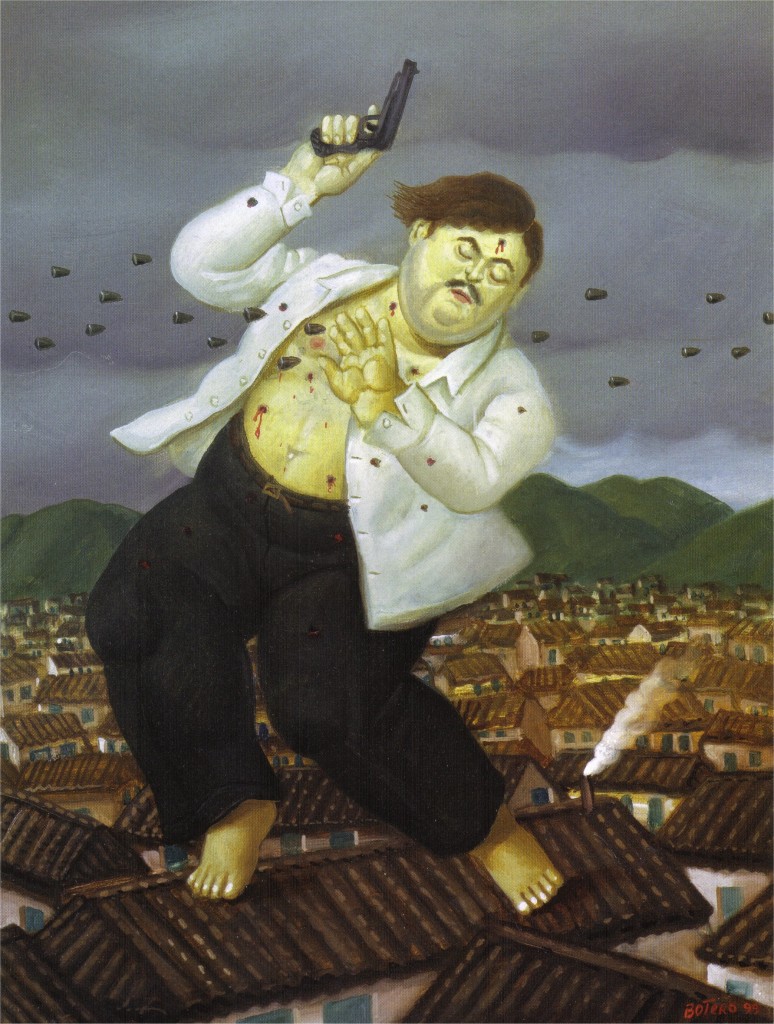A Visit to La Catedral, Pablo Escobar’s Prison, Part II
posted on November 22nd, 2015 in Andes Mountains, Colombia, Pablo Escobar

The Death of Pablo Escobar, by Fernando Botero
From my travel journal: Medellín, Antioquia:
Pablo [Ochoa] and I arrive on the dirt road finally at the cluster of buildings that used to house Pablo Escobar, his brother and other Medellin Cartel associates. But the road to the buildings is blocked by an empty kiosk and a gate with a chain lock. No one is manning the kiosk. So we drive further up the hill to a cluster of new buildings, that lie above the prison. The buildings are part of a Benedictine Monastery that was built about five years ago and we part before a small, A-frame chapel built of wood. From inside comes music in form of Gregorian chants. Far below us, in glimpses through the clouds, rise the pink skyscrapers of El Poblado, a wealthy suburb of Medellin.
Inside, the chapel is empty, the music turns out to be a recording and there are wooden pew benches. On a wall is a statue of Christ, surrounded by pictures of the stations of the cross. A 40ish man approaches us. He’s a bit lean and gaunt and tells us he a priest. He offers to give us a tour but not before another cab arrives and a shirtless man gets out, covered in tattoos, makes his way inside, and kneels at a pew. He looks like a gangster and has traveled all of the way up the mountainside to pray.
Six nuns live here, the priest tells us, leaving the tattooed man to pray. he leads us to the nuns’ houses, which look like they are made of gingerbread. They have small gardens before them. No nuns are visible, but the gardens have large, elephant-eared plants that are purple in color. “We brought them from the forest,” the priest tells us, gesturing to the dark trees that cling to the hills. He shows us the confession room, the library of donated books, and finally to his office, which doubles as a small store. Inside is a glass counter and shelves on them are various handicrafts the nuns make: rosaries, key chains with the images of saints, etc. All of them are for sale.
“Colombia will soon have its first saint,” the priest says, and gestures to a portrait on the wall of an attractive woman wearing a white habit with a beatific face. The portrait is that of Laura Montoya [converted into a saint in 2103 by the Pope], who was born in the region and worked with indigenous people. “Would you like to purchase something?, the priest asks.
I purchase 15,000 pesos worth of rosaries, keychains, and other knick knacks. My driver then asks the priest if we can visit the prison below.
“I’m sorry,” he says, “it will have to be another time. There are electrified fences,” he says gravely, putting the money away.
We walk outside, looking down at the prison complex, and the green field before it, and below that forest and the winding road and the city of Medellin in the distance, swathed in clouds.
“Look there,” my driver Pablo says, pointing at the field. “that’s Escobar’s soccer field.” The field is non-descript, overgrown, but with two while goal posts at either end. “They found a body buried there after his escape,” Pablo says, in a low voice. “It was cut into pieces.”
“Maybe so,” I reply, “but it’s a hell of place to be buried. There’s probably no other soccer field with better view in the world.”
We drive back down the road and drive past the kiosk again, but this time there is someone inside. My driver asks if we can pass through the gate; the guard is friendly, pulls out some keys, undoes the lock and chain, pushes the gate open, then waves us through. Obviously, he has not spoken to the priest. We drive inside, park, and get out. There’s no sign of electric fences anywhere. Just a sign put up by the Benedictines counseling against “envy.” Pablo and I look at each other.
“The priest lied to us,” I say.
Pablo nods.
“I think he just wanted to sell you some stuff,” he replies.
Looking up at the dented cement walls that look a bit like Hitler’s bunker, I can’t help but think that if a Colombian priest is more concerned with selling indulgences and lying to visitors than with telling the truth–then why should anyone be surprised at the behavior of Colombian criminals?”
Next: A visit to Escobar’s Prison
